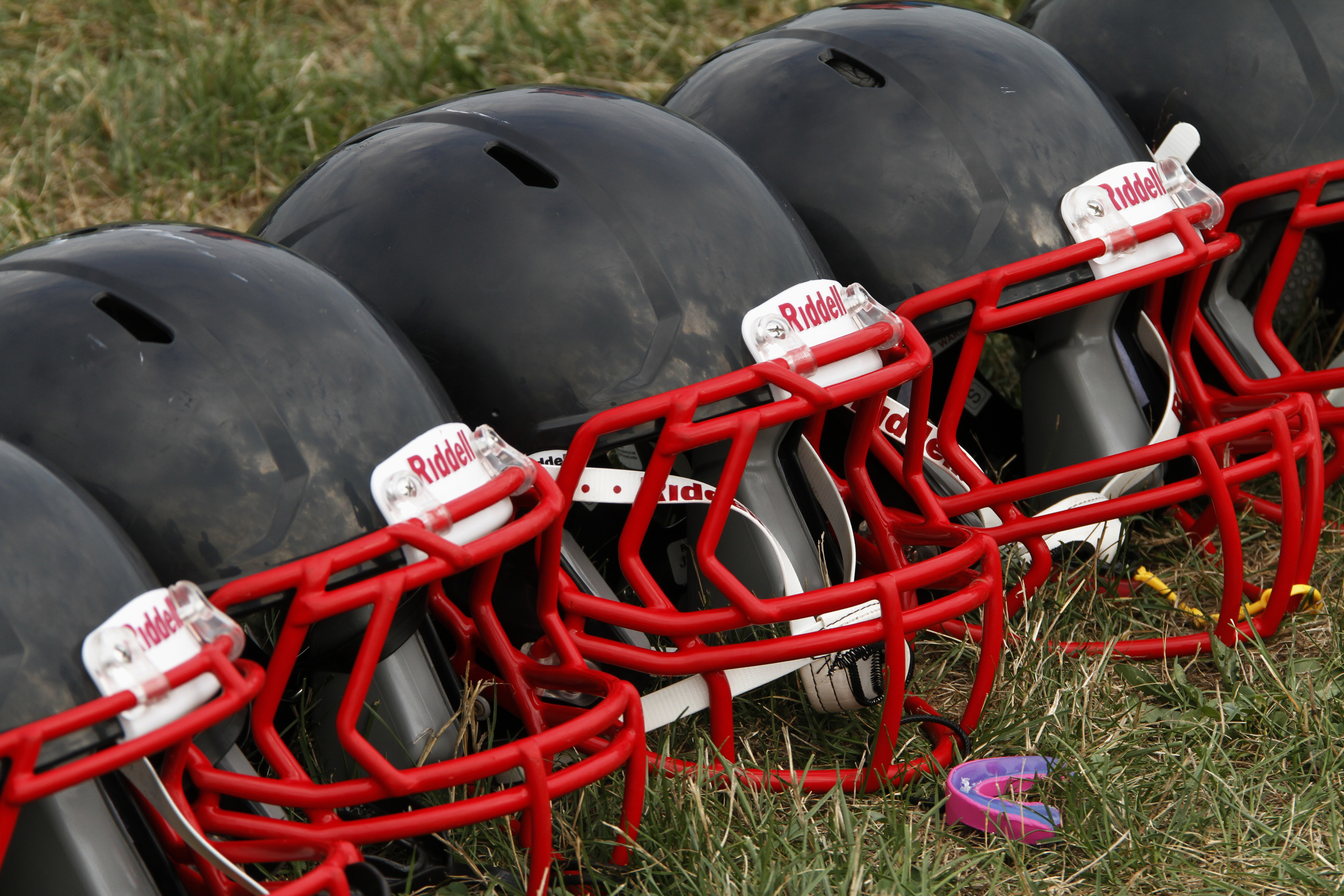Study reveals more questions than answers on youth sports concussions
Thursday, October 31, 2013
 New football helmets that were given to a group of youth football players from the Akron Parents Pee Wee Football League, in Akron, Ohio. A new report says too little is known about concussion risks for young athletes, and it's not clear whether better headgear is an answer. The panel stresses wearing proper safety equipment. But it finds little evidence that current helmet designs, face masks and other gear really prevent concussions, as ads often claim.
New football helmets that were given to a group of youth football players from the Akron Parents Pee Wee Football League, in Akron, Ohio. A new report says too little is known about concussion risks for young athletes, and it's not clear whether better headgear is an answer. The panel stresses wearing proper safety equipment. But it finds little evidence that current helmet designs, face masks and other gear really prevent concussions, as ads often claim.AT A GLANCEHighlights from the report:• Among people 19 and younger, 250,000 were treated in emergency rooms for concussions and other sports- or recreation-related brain injuries in 2009, up from 150,000 in 2001.• For male athletes in high school and college, concussion rates are highest for football, ice hockey, lacrosse and wrestling.• For females, soccer, lacrosse and basketball head the list. Women's ice hockey has one of the highest reported concussion rates at the college level.Source: Institute of Medicine and National Research CouncilCLOSER TO HOMETennessee and Georgia are among the 49 states that have passed concussion laws to regulate how youth athlete concussions are handled.Tennessee -- Tennessee's law, passed this year, states that any student who shows signs of having a concussion will be immediately removed from a sporting event and evaluated. Students won't be able to resume the sport until a medical professional clears their return. Further, all schools must adopt concussion policies. Schools are also required to adopt guidelines to educate coaches and other school leaders about the dangers of head injuries.Georgia -- In Georgia, the law also states that athletes showing concussion symptoms must be removed immediately and not play again until they are medically cleared. In addition, all high school coaches must take an online course on concussion management.
WASHINGTON - No one knows how often the youngest athletes suffer concussions. It's not clear if better headgear is the answer, and it's not just a risk in football.
A new report reveals big gaps in what is known about the risk of concussion in youth sports, especially for athletes who suit up before high school.
The Institute of Medicine and National Research Council on Wednesday called for a national system to track sports-related concussions and start answering those questions.
Despite a decade of increasing awareness of the seriousness of concussions, the panel found that young athletes still face a "culture of resistance" to reporting the injury and staying on the sidelines until it's healed.
"Concussion is an injury that needs to be taken seriously. If an athlete has a torn ACL on the field, you don't expect him to tape it up and play," said IOM committee chairman Dr. Robert Graham, who directs the Aligning Forces for Quality national program office at George Washington University.
"We're moving in the right direction," Graham added.
But the panel found evidence, including testimony from a player accused by teammates of wimping out, that athletic programs' attention to concussions varies.
Scott Bruce, founder of the Chattanooga Concussion Prevention Initiative, said the findings of the study didn't surprise him.
Many schools simply haven't made concussion policies a priority, and many student athletes simply put the value of playing time above safety concerns.
"Athletes have been hiding their concussions and other injuries for years," Bruce said. "I can see where a kid gets injured, any injury, he or she doesn't say anything because they don't want to miss any opportunities to play."
Bruce said he wishes more schools encouraged education programs so athletes can grasp the seriousness and long-term consequences of concussions and other injuries.
Reports of sports concussions are on the rise, amid headlines about former professional players who suffered long-term impairment after repeated blows. Recent guidelines make clear that anyone suspected of having a concussion should be taken out of play immediately and not allowed back until cleared by a trained professional.
A concussion is a traumatic brain injury that alters the way the brain functions, according to the Mayo Clinic website. Effects are usually temporary and can include problems with headache, concentration, memory and more.
Although millions of U.S. children and teens play school or community sports, it's not clear how many suffer concussions, in part because many go undiagnosed.
But Wednesday's report said among people 19 and younger, 250,000 were treated in emergency rooms for concussions and other sports- or recreation-related brain injuries in 2009, up from 150,000 in 2001.
Rates vary by sport.
For male athletes in high school and college, concussion rates are highest for football, ice hockey, lacrosse and wrestling. For females, soccer, lacrosse and basketball head the list. Women's ice hockey has one of the highest reported concussion rates at the college level.
College and high school sports injuries are tracked, but there's no similar data to know how often younger children get concussions, whether on school teams or in community leagues, the IOM panel said.
"One thing that parents question is, 'Well, should I let my son or daughter play this sport they're asking me to play?'" said sports injury specialist Dawn Comstock of the University of Colorado, who reviewed the report. "If we don't have that type of data on the national level, it's very difficult" to know.
Bruce said he sees two extremes in the parents he encounters through his work: The "suck it up" mentality of parents who tell their children that a concussion is par for the course, and parents who pull their children out of sports altogether based on their fears. Bruce mainly encourages awareness, and quick, thorough reaction to an injury.
"I think parents need to be aware of what's happening in the sport and on the field," said Bruce. "Know what the signs and symptoms of head injuries, and know how to manage them."
Could safety gear prevent kids' concussions?
Some equipment ads make that claim. But there's little scientific evidence that current sports helmet designs or other gear, such as face masks or headbands for soccer, really reduce the risk, the panel cautioned.
Still, it stressed that youngsters should wear helmets and other sport-appropriate safety gear, because they guard against other injuries, including skull fractures and face injuries.
"Parents deserve to know how safe their children's safety equipment really is," said Sen. Tom Udall, D-N.M., who is pushing legislation to curb false advertising and encourage improvements to sports equipment standards.
"While we can't reduce every risk, we should do everything we can to stop misleading advertising that gives parents a false sense of security."
The report found that every state except Mississippi has passed a concussion law since Washington started the trend in 2009, prompted by a 13-year-old who suffered permanent disability after returning to a football game despite a concussion.
The laws address such things as criteria for removal from play and standards for return-to-play decisions, but the report said most are in the early stages of being implemented.
It's not always easy to spot a concussion -- symptoms might not be obvious right away -- yet most young athletes practice and play without routine access to a professional trained to check them, the panel said. That can leave the decision to bench players up to coaches and parents.
That's especially true before high school and in community leagues, said Tamara Valovich McLeod with the National Athletic Trainers' Association, which long has pushed for concussion education.
Without training, people may not realize you can have a concussion without losing consciousness, or that you can still have symptoms despite a clean CT scan, she said.
Typically, youth athletes recover from a concussion within two weeks. But in 10 percent to 20 percent of cases, symptoms can persist for weeks, months, occasionally even longer, the report found. A second blow before full recovery is especially dangerous.
Nor is the concern only about physical activity.
The American Academy of Pediatrics this week said teachers may need to ease students back into learning after a concussion.
There's increasing evidence that too much mental activity can prolong recovery, too. Sensitivity to light, headaches or memory difficulties may require breaks or extra time on assignments when the student returns to class, the pediatricians' policy says.
The IOM report also said:
• Youths who have already had a concussion are at higher risk for subsequent ones.
• Calls for a "hit count" to limit the number of head impacts in a week or a season make sense, but there's no evidence to say what that number should be.
n Sports officials should examine if there are age-specific rules to make play safer, such as Canadian youth hockey's no-checking rule for the youngest players.
But the report shouldn't scare parents into pulling their kids out of sports, injury expert Comstock stressed.
"The positives of sports as a physical activity still far outweigh the negatives," she said. "We just need to make it as safe as possible."
Staff writer Kate Harrison contributed to this report.

